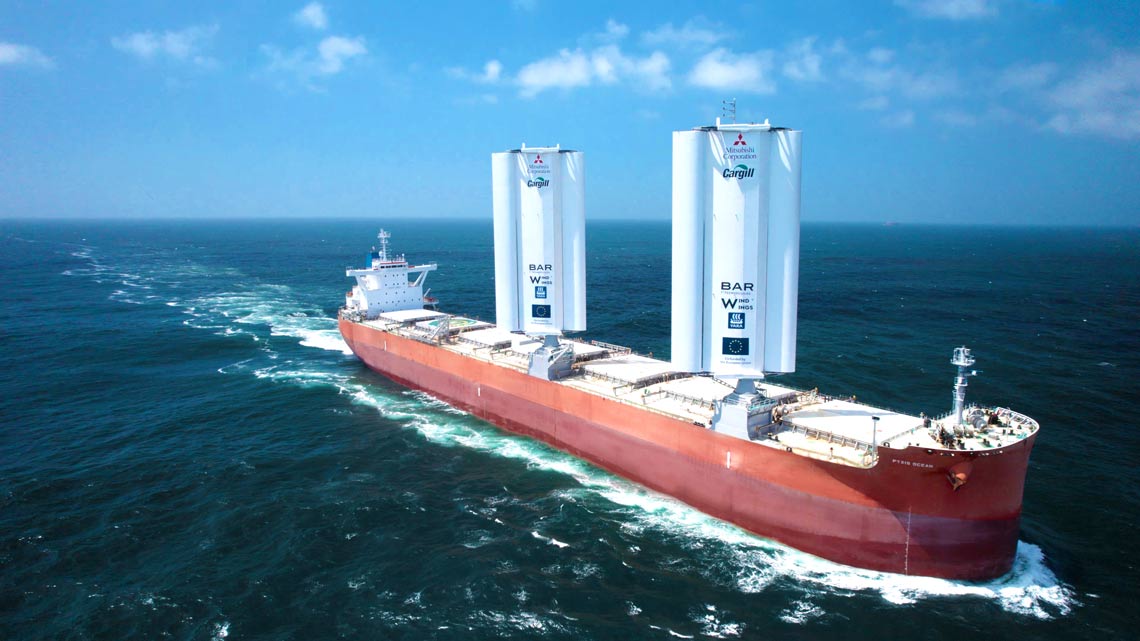
The shipping industry, responsible for nearly 3% of global CO2 emissions, has embarked on a pivotal journey towards a sustainable future. Collaborative efforts by Cargill, a leading ship charterer, BAR Technologies, Yara Marine Technologies, and Mitsubishi Corporation have led to the development of a promising solution – WindWings technology. This innovation, aimed at harnessing the power of wind for propulsion, has the potential to significantly reduce the carbon footprint of cargo shipping.
1. The Maiden Voyage of Pyxis Ocean
The Pyxis Ocean, an 80,000-tonne bulk carrier chartered by Cargill, recently set sail on its maiden voyage – a voyage that marks a crucial turning point for the maritime industry. Embarking from Shanghai and heading towards Singapore, the vessel is the first to be retrofitted with WindWings. The journey of Pyxis Ocean serves as a real-world test for this ground-breaking technology.
2. WindWings: An Overview
WindWings are large, rigid wing sails, measuring up to 37.5 meters in height, attached to the deck of cargo ships. Developed by the UK firm BAR Technologies and manufactured by Yara Marine Technologies, these sails are designed to harness the power of wind to propel the ship, thereby reducing fuel consumption and corresponding CO2 emissions.
3. The Potential of Wind Power in Propulsion
“Wind is a near-marginal cost-free fuel and the opportunity for reducing emissions, alongside significant efficiency gains in vessel operating costs, is substantial.” – John Cooper, CEO, BAR Technologies.
Wind power is not a new concept, with sailing being the traditional method of propelling ships before the advent of steam and diesel engines. However, the modern revival of this ancient technology could be a game-changer for the shipping industry. It represents a cost-effective, renewable source of energy that could significantly reduce the sector’s reliance on fossil fuels.
4. The Impact on Fuel Consumption and Emissions
According to simulations, WindWings could bring about an average reduction in fuel consumption and CO2 emissions by 30%. This figure could increase if used in combination with alternative fuels. In essence, the WindWings technology presents a viable pathway for the shipping industry to meet its target of reducing average CO2 emissions by 30% by 2030.
5. Retrofitting: A Key Advantage of WindWings
One of the key advantages of WindWings is its potential for retrofitting on existing ships. This means that the technology is not limited to new builds, thereby making it a practical solution for a large portion of the existing global fleet. Retrofitting ships with WindWings could be a significant step towards achieving the industry’s decarbonization goals.
6. Tracking the Performance of WindWings
The performance of the WindWings will be closely monitored over the coming months. This monitoring will help to further refine the design, operation, and performance of the sails. The data collected from these monitoring efforts will be crucial in determining the scalability of the technology, not just across Cargill’s fleet but for the entire industry.
7. The Future of WindWings
“I do predict by 2025 half the new-build ships will be ordered with wind propulsion.” – John Cooper, CEO, BAR Technologies.
The future of WindWings technology is optimistic. If the trials prove successful, Cargill hopes to retrofit up to 10 more vessels with WindWings. Additionally, BAR Technologies and Yara Marine Technologies plan to build hundreds of wings over the next four years.
8. The Challenges Ahead
Despite the promising potential of WindWings, the technology does not come without its challenges. The investment is risky, and there is no guarantee of the economics working out as planned. However, these challenges are being embraced as part of the journey towards a greener future.
9. The Broader Implications
The successful implementation of WindWings could have far-reaching implications for the shipping industry and beyond. It would not only reduce the industry’s carbon emissions but also pave the way for the development and adoption of other renewable energy technologies.
10. Conclusion
The maiden voyage of the Pyxis Ocean marks a significant milestone in the shipping industry’s journey towards sustainability. It symbolizes a return to the industry’s roots, harnessing the power of wind to propel ships. If successful, WindWings technology could herald a new era of sustainable, wind-powered shipping, charting a course towards a greener future for the maritime industry.
The winds of change are certainly blowing in the shipping industry, and all eyes will be on the Pyxis Ocean as it embarks on its pioneering voyage. As this wind-powered cargo ship charts a new lower-carbon path for the maritime industry, it serves as a beacon of hope for a more sustainable future.
